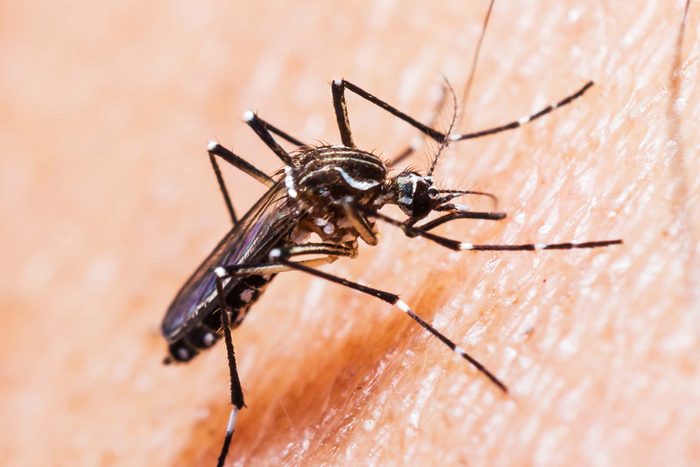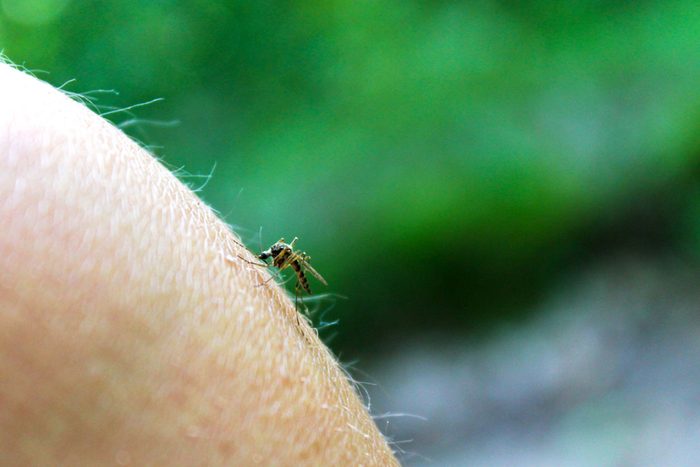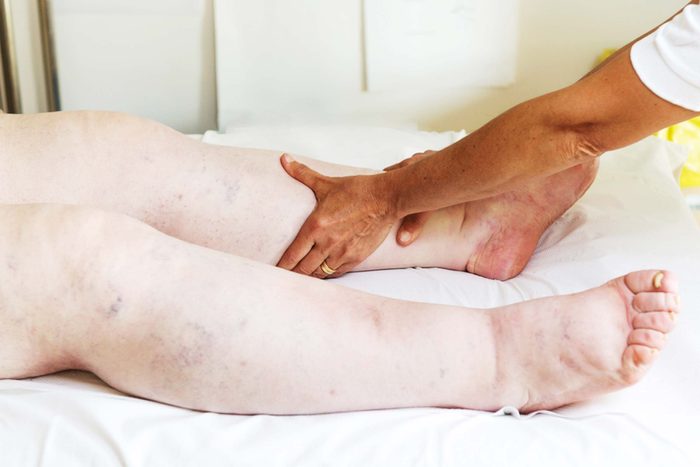Zika and beyond
Mosquito season is upon us, folks. Those pesky critters can do more than bother everyone at your upcoming barbecue, though. Some mosquitoes carry diseases that can be dangerous to some people. Zika may be one of the most-discussed, but it’s certainly not the only one that poses a threat to people who want to enjoy the outdoors this summer. In general, it’s the bug spray-and-coverup time of year.

West Nile virus
You’ve no doubt heard of this one: West Nile virus is one of the most-feared mosquito-borne diseases, but most people infected have no symptoms, and therefore don’t even realize they have it—which means you have nothing to worry about. Fewer than 1 percent of those infected can develop a serious or fatal neurological disorder, according to the Centers for Disease Control and Prevention (CDC). However, there have been outbreaks in recent years, even in the United States. According to Brad Leahy, owner and vice president of B.O.G. Pest Control in Edgewater, MD, the most common areas to find West Nile outbreaks are those that follow bird migration patterns since mosquitoes that feed on birds infected with the virus are its carriers. So far, the West Nile virus has made its way to every state and the District of Columbia, except for Hawaii and Alaska.
West Nile virus tends to behave like a case of the flu, causing headaches, body aches, fatigue, joint pain, diarrhea, vomiting, and sometimes a rash. Signs that it could become more severe include high fever, stiffness, seizures, coma, or paralysis in any part of the body. There is no vaccine available for West Nile, and severe cases require hospitalization.
To protect yourself against mosquitoes potentially carrying West Nile virus, keep your skin protected, wear mosquito repellant spray, and consider these home remedies for mosquitoes before you head outside.

Dengue virus
Yellow fever mosquitoes, which are responsible for Zika, chikungunya, and—yes—yellow fever, can also transmit dengue virus, says Leahy. Commonly found in tropical climates, dengue in the United States is mostly a threat along the southern border.
Common symptoms of dengue virus include rash, muscle, joint, or bone pain, severe headache, eye pain, and mild bleeding from the nose or gums. More severe symptoms include vomiting blood, cold or clammy skin, black or tarry stools, and severe abdominal pain. Extreme cases can lead to circulatory failure and death. There’s currently no treatment for the disease, but most people can lower the severity of symptoms with pain-relieving drugs and drinking plenty of water to stay hydrated.
The best prevention for dengue virus, like other mosquito-borne diseases, is avoiding mosquito bites, especially if you’re already feeling ill or have a fever. (Learn about the 12 diseases you didn’t know you could get on vacation.)

Western equine encephalitis
Typically transmitted by Culex mosquitoes—the type you usually see buzzing around your backyard—most cases of Western equine encephalitis (WEE) have occurred west of the Mississippi River, west of the Rocky Mountains, and in California. “It’s a disease of horses primarily, but humans can get it,” says medical entomologist Joseph M. Conlon, spokesperson for the American Mosquito Control Association. “It has about a 60 to 70 percent fatality rate and those it doesn’t kill remain in a vegetative state. Thankfully it’s very uncommon.”
In fact, fewer than 700 cases have been confirmed in the United States since 1964. Elderly people are most at risk for severe, or fatal, symptoms. Most people develop flu-like symptoms, like nausea, vomiting, headache, and body aches. “It’s a classic mosquito-borne virus,” Conlon says of the symptoms. “They all mimic each other so it’s hard to differentiate them.” Unfortunately, there’s only a vaccine available for horses, so humans should avoid the outdoors at dusk and dawn when these mosquitoes are most active.

Chikungunya
This African virus has hit the international scene thanks to the hardiness and adaptibility of the Asian tiger mosquito (yellow fever skeeters can also carry the virus). Although the virus is rare in the United States, travelers from the most affected areas, like Africa, India, and Asia, can transport it.
The virus mirrors many of the same symptoms as dengue and Zika, including headaches, body aches, muscle and joint pain, and fever which usually turn up between three and seven days after a bite. The groups at highest risk for severe complications are the elderly and newborns—but severe reaction is rare.
There’s no vaccine to protect against chikungunya, so investing in a protective insect repellent before traveling or spending time outdoors is especially important. Leahy recommends a repellent with DEET, IR3535, oil of lemon eucalyptus, or picaridin for the best protection.

Yellow fever
Yellow fever comes by way of—no surprise—the yellow fever mosquito, though tiger mosquitoes also carry this virus, which is found mostly in tropical areas of Africa and South America. “It’s called yellow fever because of the jaundice associated with it,” says Conlon. “It affects many organs and one of them is the liver.” It’s rarely transferred to the United States via travelers, thanks to a live-virus vaccine given to people before they travel. Yellow fever symptoms typically begin three to six days after a bite and can include headache, body aches, nausea, vomiting, and fever.
“It’s extremely difficult to treat,” says Conlon. “With any mosquito-borne virus, you’re treating the symptoms—you’re not going to eliminate the virus itself. So you might get better, or you might not.” In about 15 percent of cases, people will seem as though they’re getting better before taking a turn for the worse, with a high fever, jaundice, and body organ failures, according to the CDC. The severe form has up to a 50 percent mortality rate. (Here are 9 immunizations and medications you need to know about before you travel.)

Lymphatic filariasis
One of the lesser-known mosquito-borne diseases, lymphatic filariasis also is one of the most dangerous. The infection is caused by a parasitic worm transferred by several types of mosquitoes and is found in several countries in Africa, South America, and the Western Pacific. It doesn’t commonly transfer to the United States from travelers.
The parasite can cause extreme swelling in the arms, legs, or genitalia. Hardening of the skin, known as elephantiasis, may also occur. A drug known as DEC can kill the infection and the parasites that cause it when used for its full 12-day regimen.
Since the types of mosquitoes that transmit lymphatic filariasis are numerous, it’s important to protect yourself if you’re traveling to an infected area. If you’re outside between dawn and dusk, Leahy suggests using a “mosquito net that has been treated with insecticide will shield you from bites, especially at dusk, when mosquitoes are most active.” (Check out these 8 trusted mosquito-repelling products you’ll actually want to use.)

Japanese encephalitis
Japanese encephalitis is transmitted to humans through Culex mosquitoes in Asia and the Western Pacific. An infection can cause fever, headache, and vomiting, and very rare cases lead to neurological symptoms and seizures.
According to Leahy, the risk of humans contracting the virus, even when traveling to affected areas, is low. “The Culex mosquitoes which carry this disease breed in agricultural zones and flooded rice fields and are more likely to bite at night,” he says. Your best bet at prevention is to stay indoors at night and use mosquito netting.

St. Louis encephalitis
The first-ever diagnosed case of St. Louis encephalitis was in—you guessed it—St. Louis. Transferred to humans by the Culex mosquito, it concentrates mainly within the United States, specifically in central and eastern states, says Conlon. According to the CDC, about 99 percent of cases go undiagnosed because they resolve with no symptoms. However, there’s a higher risk of serious complications in older adults than in children. Common symptoms include fever, dizziness, and nausea, and can go from mild to severe rapidly. Severe cases can result in coma, and the elderly population is especially at risk of developing encephalitis, or brain inflammation, says Conlon.
There’s no vaccine or treatment available for this virus. Although the number of cases in the United States has dwindled in recent years, it still exists, so be mindful of active mosquito periods in your area and protect yourself. (Learn the scientific reason you are (or aren’t) a mosquito magnet.)

La Crosse encephalitis
The first case of La Crosse encephalitis (LCEV) was diagnosed in La Crosse, Wisconsin. “It’s transported by mosquitoes that like to breed in tree holes,” says Conlon. Unfamiliar with that breed? You probably don’t live in the southern, upper Midwest, or mid-Atlantic states where the mosquitoes are prevalent and most of LCEV cases cluster. Usually, LCEV goes unnoticed, with extremely mild or no symptoms, but it can be dangerous to teens and children 16 and under. Fever, vomiting, and fatigue are the most common symptoms; seizures can accompany even mild forms of the virus. In extremely rare cases, neurological symptoms can cause long-term paralysis or disability, and can sometimes be fatal. No vaccine or treatments for LCEV exist, says Conlon, so it’s important to keep yourself and your yard protected. You won’t be surprised to hear that the mosquitoes typically lay eggs in tree holes so prevent breeding by filling the holes with soil. (Here are 7 bug bites you should never, ever ignore.)

Eastern equine encephalitis
Eastern equine encephalitis (EEE) is “one of the most severe mosquito-transmitted diseases in the United States, though most people don’t know about it,” says Leahy. “Almost one-third of people infected with Eastern equine encephalitis die, and many survivors face varying levels of brain damage.” Florida, New Jersey, and Georgia have seen the highest number of EEE cases, but states near the Great Lakes are close behind.
Culiseta melanura mosquitoes are responsible for this virus, which has no vaccine or treatment. Symptoms can be systemic, with chills, fever, and body aches, or encephalitic, with vomiting, convulsions, and coma. Since these mosquitoes especially love a good water breeding ground, make sure any standing water in your yard is emptied promptly. (And while you’re preventing and treating your mosquito bites, keep in mind these 6 surprising dos and don’ts of mosquito bites.)

Venezuelan equine encephalitis
Closely related to Eastern equine encephalitis, Venezuelan equine encephalitis (VEE) is thankfully not as common in the United States—yet, says Leahy. He says that it’s possible the mosquitoes that transmit the virus could make their way from South and Central America to the southern border of the United States.
VEE carries many of the same symptoms as EEE, but may also pose a high risk to the fetuses of pregnant women, resulting in miscarriage. Most people feel relief from symptoms within five days of onset, but in rare cases, the virus can be fatal. While mosquito season is in full swing, it’s still important that you pay attention to other types of bug bites you notice. (Here are 8 ways to prevent birth defects before and during pregnancy.)